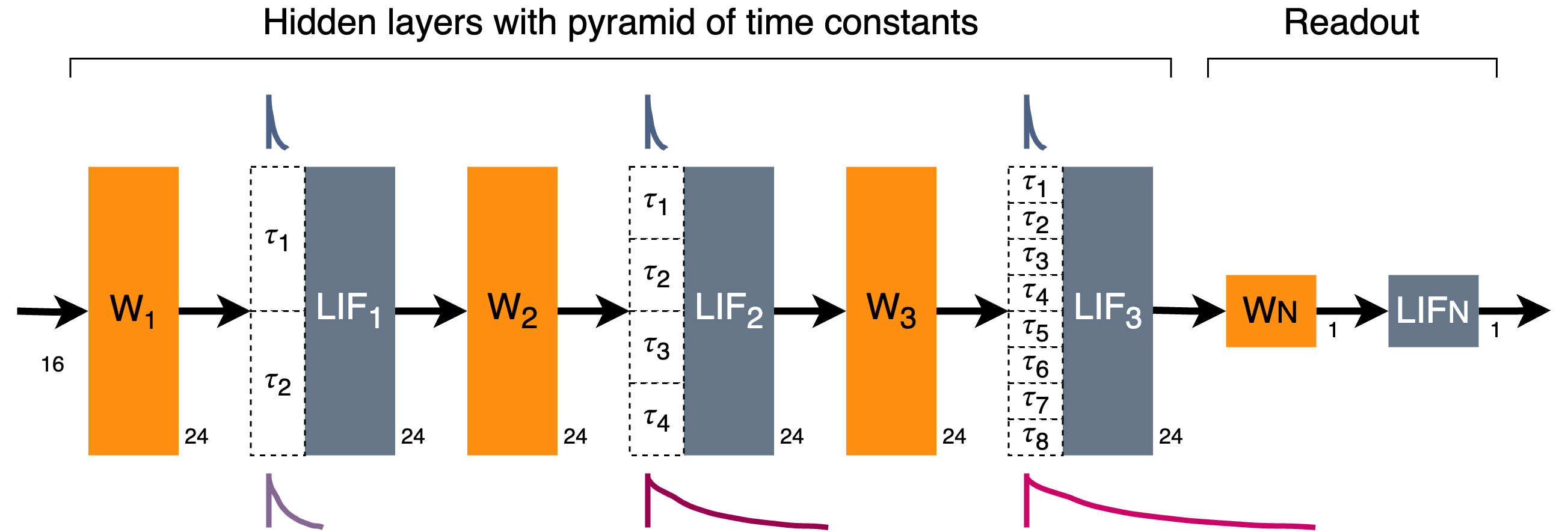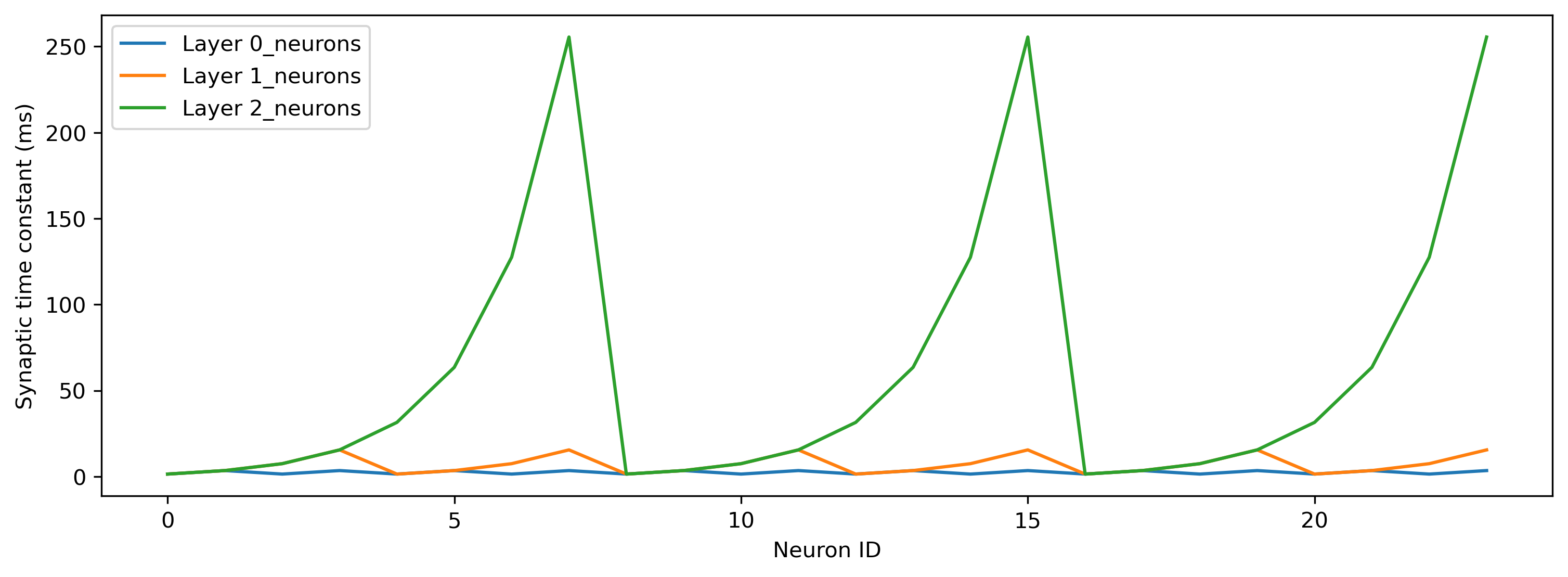This page was generated from docs/tutorials/synnet/synnet_architecture.ipynb.
Interactive online version:
The SynNet architecture
This tutorial describes a simple feed-forward architecture designed for spiking networks, for temporal signal processing applications. This architecture has been validated and published in [1, 2].
[1] Bos & Muir 2022. “Sub-mW Neuromorphic SNN audio processing applications with Rockpool and Xylo.” ESSCIRC2022. https://arxiv.org/abs/2208.12991
[2] Bos & Muir 2024. “Micro-power spoken keyword spotting on Xylo Audio 2.” arXiv. https://arxiv.org/abs/2406.15112
[1]:
from IPython.display import Image
try:
from rich import print
except:
pass
Image("illustration_signals.png")
[1]:

Architecture description
The network consists of several hidden spiking layers, connected in a dense feed-forward chain with interleaved linear weights. The synaptic time constants of the hidden layers are initialised with a range of values from a minimum time constant up to many multiples of the minimum time constant, in a geometric series. This allows the network to extract and use temporal features over a range of temporal durations.
The network is specified by providing the number of input and output channels, and lists of the layer sizes and numbers of time constants in each layer.
A simple example is shown below, with 16 input channels; three hidden layers of 24 neurons each; and 1 output channel. Default membrane and base synaptic time constants of 2ms are used, along with a default time-step dt of 1ms.
[2]:
# - Display the network architecture to be used
Image("synnet-3-layer.png")
[2]:

[3]:
# - Import the SynNet architecture class
from rockpool.nn.networks import SynNet
# - Build a simple SynNet with three hidden layers
net = SynNet(
n_channels = 16, # Number of input channels
n_classes = 1, # Number of output classes (i.e. output channels)
size_hidden_layers = [24, 24, 24], # Number of neurons in each hidden layer
time_constants_per_layer = [2, 4, 8], # Number of time constants in each hidden layer
)
print(net)
SynNet with shape (16, 1) {
TorchSequential 'seq' with shape (16, 1) {
LinearTorch '0_linear' with shape (16, 24)
LIFTorch '0_neurons' with shape (24, 24)
LinearTorch '1_linear' with shape (24, 24)
LIFTorch '1_neurons' with shape (24, 24)
LinearTorch '2_linear' with shape (24, 24)
LIFTorch '2_neurons' with shape (24, 24)
LinearTorch 'out_linear' with shape (24, 1)
LIFTorch 'out_neurons' with shape (1, 1)
}
}
/Users/dylan/SynSense Dropbox/Dylan Muir/LiveSync/Development/rockpool_GIT/rockpool/nn/networks/__init__.py:15: UserWarning: This module needs to be ported to teh v2 API.
warnings.warn(f"{err}")
/Users/dylan/SynSense Dropbox/Dylan Muir/LiveSync/Development/rockpool_GIT/rockpool/nn/networks/__init__.py:20: UserWarning: This module needs to be ported to the v2 API.
warnings.warn(f"{err}")
Synaptic time constants are generated automatically, in a geometric series starting from the base time constant (2ms by default). Membrane time constants are identical for all layers (2ms by default). Below we plot the synaptic time constants in each spiking layer in turn.
[4]:
# - Import the matplotlib plotting library
import matplotlib.pyplot as plt
plt.rcParams["figure.figsize"] = [12, 4]
plt.rcParams["figure.dpi"] = 300
# - Plot the synaptic time constants for each layer
for lyr in net.lif_names[:-1]:
plt.plot(net.seq[lyr].tau_syn / 1e-3, label = f"Layer {lyr}")
plt.xlabel('Neuron ID')
plt.ylabel('Synaptic time constant (ms)')
plt.legend();

Accessing internal layers
The network architecture is instantiated as a Sequential network internally, available under the seq attribute.
SynNet objects also provide the convenience attribute lif_names, a list containing the names of each of the neuron layers in the network in turn.
The final layer is the readout neuron layer.
[5]:
# - Show the internal `Sequential` module
print(net.seq)
# - Print the list of neuron layer names
print(f"lif_names: {net.lif_names}")
TorchSequential 'seq' with shape (16, 1) {
LinearTorch '0_linear' with shape (16, 24)
LIFTorch '0_neurons' with shape (24, 24)
LinearTorch '1_linear' with shape (24, 24)
LIFTorch '1_neurons' with shape (24, 24)
LinearTorch '2_linear' with shape (24, 24)
LIFTorch '2_neurons' with shape (24, 24)
LinearTorch 'out_linear' with shape (24, 1)
LIFTorch 'out_neurons' with shape (1, 1)
}
lif_names: ['0_neurons', '1_neurons', '2_neurons', 'out_neurons']
The seq attribute can be conveniently used to access internal network layers and their parameters.
[6]:
lyr = net.seq[net.lif_names[0]]
print(lyr)
lyr_out = net.seq[-1]
print(lyr_out)
LIFTorch '0_neurons' with shape (24, 24)
LIFTorch 'out_neurons' with shape (1, 1)
[7]:
for name, lyr in net.seq.modules().items():
if 'linear' in name:
print(lyr)
LinearTorch '0_linear' with shape (16, 24)
LinearTorch '1_linear' with shape (24, 24)
LinearTorch '2_linear' with shape (24, 24)
LinearTorch 'out_linear' with shape (24, 1)
Modifying the architecture
By default, the output of the network are the spikes generated by the readout neuron layer.
An alternative is to use the membrane potential vmem of the readout layer as the network output.
This can facilitate training, by permitting a target membrane potential to be used instead of a target spike train.
This can be selected using the output argument to __init__(), as well as dynamically using the output attribute.
[ ]:
net = SynNet(
output="vmem", # Use the membrane potential as the output of the network
n_channels = 16, # Number of input channels
n_classes = 1, # Number of output classes (i.e. output channels)
size_hidden_layers = [24, 24, 24], # Number of neurons in each hidden layer
time_constants_per_layer = [2, 4, 8], # Number of time constants in each hidden layer
)
net.output = "spike"
By default, torch compatible modules are used to generate the network, using the LIFTorch Rockpool module.
This can be specifed with the neuron_model argument to __init__().
A good alternative module to use would be LIFExodus, for acceleraed CUDA-based training of SNNs.
[8]:
from rockpool.nn.modules import LIFTorch as LIFOtherSpiking
net = SynNet(
neuron_model=LIFOtherSpiking, # Specify a different neuron model to use
n_channels = 16, # Number of input channels
n_classes = 1, # Number of output classes (i.e. output channels)
size_hidden_layers = [24, 24, 24], # Number of neurons in each hidden layer
time_constants_per_layer = [2, 4, 8], # Number of time constants in each hidden layer
)
Also by default, hidden layer time constants and thresholds are not trainable.
This can be overridden with the train_time_constants and train_threshold arguments to __init__().
[9]:
net = SynNet(
train_time_constants = True, # Specify to train time constants
train_threshold = True, # Specify to train thresholds
n_channels = 16, # Number of input channels
n_classes = 1, # Number of output classes (i.e. output channels)
size_hidden_layers = [24, 24, 24], # Number of neurons in each hidden layer
time_constants_per_layer = [2, 4, 8], # Number of time constants in each hidden layer
)
net.seq['0_neurons'].parameters()
[9]:
{'tau_mem': Parameter containing:
tensor(0.0014, requires_grad=True),
'tau_syn': Parameter containing:
tensor([[0.0014],
[0.0035],
[0.0014],
[0.0035],
[0.0014],
[0.0035],
[0.0014],
[0.0035],
[0.0014],
[0.0035],
[0.0014],
[0.0035],
[0.0014],
[0.0035],
[0.0014],
[0.0035],
[0.0014],
[0.0035],
[0.0014],
[0.0035],
[0.0014],
[0.0035],
[0.0014],
[0.0035]], requires_grad=True),
'threshold': Parameter containing:
tensor(1., requires_grad=True)}
SynNet provides the ability to insert dropout layers during training, using the p_dropout argument to __init__().
p_dropout is a float [0..1], specifying the per-time-step-per-neuron dropout probability to use.
By default this is 0.0, and no dropout layers are inserted.
If p_dropout > 0, then dropout layers will be inserted in the network.
[10]:
net = SynNet(
p_dropout = 0.1, # Dropout proportion to use
n_channels = 16, # Number of input channels
n_classes = 1, # Number of output classes (i.e. output channels)
size_hidden_layers = [24, 24, 24], # Number of neurons in each hidden layer
time_constants_per_layer = [2, 4, 8], # Number of time constants in each hidden layer
)
print(net)
SynNet with shape (16, 1) {
TorchSequential 'seq' with shape (16, 1) {
LinearTorch '0_linear' with shape (16, 24)
LIFTorch '0_neurons' with shape (24, 24)
TimeStepDropout '0_dropout' with shape (24,)
LinearTorch '1_linear' with shape (24, 24)
LIFTorch '1_neurons' with shape (24, 24)
TimeStepDropout '1_dropout' with shape (24,)
LinearTorch '2_linear' with shape (24, 24)
LIFTorch '2_neurons' with shape (24, 24)
TimeStepDropout '2_dropout' with shape (24,)
LinearTorch 'out_linear' with shape (24, 1)
LIFTorch 'out_neurons' with shape (1, 1)
}
}
Training a SynNet
This architecture can be trained with a standard torch training loop. The below toy example simply shows the mechanics, without a real task.
[23]:
n_epochs = 10
n_batch = 1
n_time = 100
n_channels = 4
n_classes = 1
# - Generate a SynNet
net = SynNet(
n_channels=n_channels,
n_classes=n_classes,
size_hidden_layers=[4],
)
# - Import torch training utilities
import torch
from torch.optim import Adam
from torch.nn import MSELoss
# - Try to use tqdm
try:
from tqdm.notebook import trange
except:
trange = range
# - Get the optimiser functions
optimizer = Adam(net.parameters().astorch(), lr=1e-3)
# - Loss function
loss_fun = MSELoss()
# - Record the loss values over training iterations
accuracy = []
loss_t = []
[24]:
input_sp = (torch.rand(1, 100, 4) < 0.01) * 1.0
target_sp = torch.ones(1, 100, 1)
for epoch in trange(n_epochs):
optimizer.zero_grad()
output, _, _ = net(input_sp)
loss = loss_fun(output, target_sp)
loss.backward()
optimizer.step()
Next steps
See another example of training an SNN using torch in 🔊 Training an audio classification task using Torch 🔥.